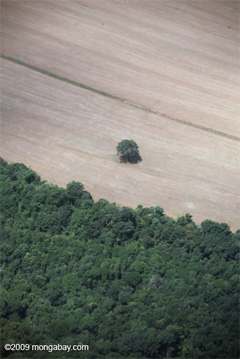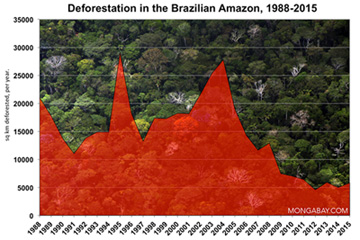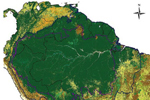Scientists’ write that press release based on study was “misleading and inaccurate”.
Recently, Boston University issued a press release on a scientific study regarding the Amazon’s resilience to drought. The press release claimed that the study had debunked the Intergovernmental Panel on Climate Change’s (IPCC) theory that climate change could turn approximately 40 percent of the Amazon into savanna due to declining rainfall. The story was picked up both by mass media, environmental news sites (including mongabay.com), and climate deniers’ blogs. However, nineteen of the world’s top Amazonian experts have issued a written response stating that the press release from Boston University was “misleading and inaccurate”.
The study in question, published in Geophysical Research Letters, showed that the forests’ level of ‘greenness’ had not changed during the 2005 year drought (see mongabay.com’s original coverage of the study and press release: Amazon confusion: new research shows forest is resilient to drought, but is this the whole picture?). However it was not the study, but the press release, entitled ‘New study debunks myths about Amazon rain forests’, that has disturbed some of the world’s most notable Amazon experts.
 Forest clearing in the Amazon: Mato Grosso, Brazil. Photo by Rhett A. Butler. |
“[The press release] claims that the study ‘debunks myths about Amazon rainforests’, which is simply not true,” the experts’ letter reads. “First, there is no myth. Rather, there are multiple, consistent lines of evidence from ground—based studies published in the peer—reviewed literature that Amazon forests are, indeed, very susceptible to drought stress. Second, nothing is debunked by the new study. The new study contributes to our understanding of interpretations of data retrieved from satellites, but it does not prove or disprove anything about what is really happening on the ground.”
The researchers add that while the BU press release was inaccurate, the study it reports on has added “to our knowledge of Amazon forests”. While a previous study had shown that the Amazon may have actually benefited from the 2005 drought, i.e. the forest was ‘greener’ than usual, the new study found no change in the forests ‘greenness’.
However, the impact of drought should not only be measured by forest ‘greenness’. To prove this the letters’ experts cite a recent study that found a “large surge” in tree mortality in 2005 that was consistent with the results of two experiments showing tree mortality after rain reductions.
“These studies, published in some of the best peer—reviewed science journals, provide several consistent lines of evidence that the forests of the Amazon Basin are susceptible to small reductions in rainfall,” the experts conclude, adding that drought also increases the susceptibility of the Amazonian rainforest to fire, citing fires in 2005 and in 1998 during another drought. Unlike temperate forests, fire is a rare occurrence in rainforests unless started by humans or, in this case, caused by rare droughts.
The scientists also used the letter to defend the findings of the 2007 IPCC report, which stated that 40 percent of the Amazon could become savanna due to climate change-exacerbated drought conditions.

|
“While the IPCC statement could be criticized for citing a review paper rather than original research papers, the main conclusion of the IPCC statement—that Amazonian forests are very susceptible to reductions in rainfall—remains our best understanding of the data available at the time of the IPCC report and also today,” the letter reads.
Furthermore, the researchers note that while the IPCC report cites gray literature—a WWF report—rather than a research paper, the WWF report did not just pull its information out of thin air, but from research published in the peer-reviewed journal Nature.
The scientists say that the fact that climate change could ‘flip’ large portions of the Amazon, approximately 40 percent, into savannah, was not only accurately reflecting the research of the time, but “has been reinforced by new studies.”
The letter is signed by: Daniel Nepstad, Woods Hole Research Center, USA, and Instituto de Pesquisa Ambiental da Amazonia, Brazil; Ane Alencar, Instituto de Pesquisa Ambiental da
Amazonia,
Brazil,
and
University
of
Florida,
USA;
Greg
Asner,
Carnegie
Institute
of
Science,
USA;
Alessandro
Baccini,
Woods
Hole
Research
Center,
USA;
Paulo
Brando,
Instituto
de
Pesquisa
Ambiental
da
Amazonia,
Brazil,
&
University
of
Florida,
USA;
Foster
Brown,
Woods
Hole
Research
Center,
USA
&
Universidade
Federal
do
Acre,
Brazil;
Mercedes
Bustamante,
Universidade
de
Brasilia,
Brazil;
Eric
Davidson,
Woods
Hole
Research
Center,
USA;
Scott
Goetz,
Woods
Hole
Research
Center,
USA;
Richard
Houghton,
Woods
Hole
Research,
USA;
Michael
Keller,
National
Ecological
Observatory
Network,
USA;
Simon
Lewis,
Leeds
University,
UK;
Thomas
Lovejoy,
Heinz
Center
for
Science,
Economics
and
the
Environment,
USA;
Patrick
Meir,
University
of
Edinburgh,
UK;
Paulo
Moutinho,
Instituto
de
Pesquisa
Ambiental
da
Amazonia,
Brazil,
and
Woods
Hole
Research
Center,
USA;
Carlos
Nobre,
Centro
de
Previsao
de
Tempo
e
Clima—CPTEC,
Brazil;
Scott
Ollinger,
University
of
New
Hampshire,
USA;
Oliver
Phillips,
Leeds
University,
UK;
George
Woodwell,
Woods
Hole
Research
Center,
USA.
Related articles
Amazon confusion: new research shows forest is resilient to drought, but is this the whole picture?

(03/15/2010) A drought that happens once in a hundred years had little negative or positive effect on the Amazon rainforest according to a NASA funded study in Geophysical Research Letters. “We found no big differences in the greenness level of these forests between drought and non-drought years, which suggests that these forests may be more tolerant of droughts than we previously thought,” said Arindam Samanta, the study’s lead author from Boston University.

(02/03/2010) A claim published in the Sunday Times over the veracity of a statement published in an Intergovernmental Panel on Climate Change (IPCC) report may land the British newspaper in hot water. On Sunday, Jonathan Leake, Science & Environment Editor of the Sunday Times, accused the IPCC of making a “bogus rainforest claim” when it cited a report warning that up to 40 percent of the Amazon could be “drastically” affected by climate change. Climate change skeptics immediately seized on “Amazongate” as further evidence to discredit the IPCC just two weeks after it was found to be using shoddy glacier data in its 2007 climate assessment.
Rainforest expert agrees with IPCC: warns of ‘tipping point’ for Amazon

(02/03/2010) Amid questions over the Amazon forests’ capacity to survive climate change, a renowned tropical biologist says that in fact the fears are real, reports Tierramerica. Speaking at the Biodiversity Science Policy Conference in Paris, Thomas Lovejoy, biodiversity chair at the Washington DC-based Heinz Center for Science, Economics and the Environment, and chief biodiversity adviser to the president of the World Bank, described the Amazon rainforest as “very close to a tipping point”.
Will tropical trees survive climate change?, an interview with Kenneth J. Feeley

(09/24/2009) One of the most pressing issues in the conservation today is how climate change will affect tropical ecosystems. The short answer is: we don’t know. Because of this, more and more scientists are looking at the probable impacts of a warmer world on the Earth’s most vibrant and biodiverse ecosystems. Kenneth J. Feeley, tropical ecologist and new professor at Florida International University and the Center for Tropical Plant Conservation at the Fairchild Tropical Botanic Garden, is conducting groundbreaking research in the tropical forests of Peru on the migration of tree species due to climate change.
Emissions from cerrado destruction in Brazil equal to emissions from Amazon deforestation
(09/15/2009) Damage to Brazil’s vast cerrado grassland results in greenhouse gas emissions equivalent to those produced by destruction of the Amazon rainforest, said Carlos Minc, the country’s Environment Minister.
NASA images show huge drop in Amazon fires in 2008

(06/30/2009) New NASA research shows a sharp decline in the amount of smoke over the Amazon during the 2008 burning season, coinciding with a drop in deforestation reported last week by Carlos Minc, Brazil’s Environment Minister. Analyzing the aerosol concentrations over the Amazon each September from the past four burning seasons using the Ozone Monitoring Instrument on NASA’s Aura satellite, atmospheric scientist Omar Torres of Hampton University and several colleagues found a dramatic decline in airborne particular matter in 2008, indicating reduced incidence of fire in the region. Fire in the Amazon is primarily used by humans for land-clearing to establish cattle pasture, which now accounts for the vast majority of land-use change in the world’s largest rainforest.
Amazon could lose 60% of forest without triggering catastrophic die-off, claims new study

(06/16/2009) Brazil’s setting aside of more than 500,000 square miles (1.25 million square kilometers) of rainforest in protected areas over the past decade may effectively buffer the Amazon from the effects of climate change, preventing Earth’s largest rainforest from tipping towards arid savanna in the face of ongoing deforestation and rising temperatures, argues a new paper published in Proceedings of the National Academy of Sciences.
Amazonian region likely to become savannah due to burning, deforestation
(03/31/2009) A new analysis shows that the heavily-deforested Amazonian region of Mato Grosso is particularly susceptible to ‘savannization’ due to repeated burning that has likely depleted the region’s soils of precious nutrients. According to the study, published in the Journal of Geophyscial Research, savannization, or the process of tropical ecosystems shifting to savannah, is likely in northern Mato Grosso even if no further deforestation occurs.
Experts forecast probability of global warming tipping points
(03/16/2009) The probability of Earth’s climate passing a “tipping point” that could result in large impacts within the next two centuries is greater than 50 percent, according to research published in Proceedings of the National Academy of Sciences
85% of the Amazon rainforest may be lost due to global warming
(03/14/2009) Warming climate could decimate up to 85 percent of the Amazon rainforest by 2150, according to a new computer model.
Drought threatens the Amazon rainforest as a carbon sink

(03/05/2009) Drought in the Amazon is imperiling the rainforest ecosystem and global climate, reports new research published in Science. Analyzing the impact of the severe Amazon drought of 2005, a team of 68 researchers across 13 countries found evidence that rainfall-starved tropical forests lose massive amounts of carbon due to reduced plant growth and dying trees. The 2005 drought — triggered by warming in the tropical North Atlantic rather than el Niño — resulted in a net flux of 5 billion tons of carbon dioxide (CO2) into the atmosphere — more than the combined annual emissions of Japan and Europe — relative to normal years when the Amazon is a net sink for 2 billion tons of CO2.
Amazon rainforest in big trouble, says UN

(02/19/2009) Economic development could doom the Amazon warns a comprehensive new report from the United Nations Environment Programme (UNEP). The report — titled GEO Amazonia [PDF-21.3MB] — is largely a synthesis of previously published research, drawing upon studies by more than 150 experts in the eight countries that share the Amazon.